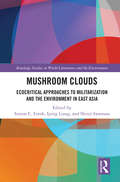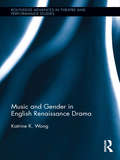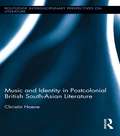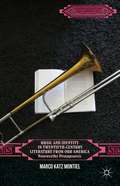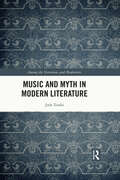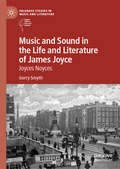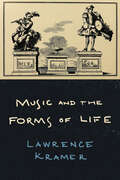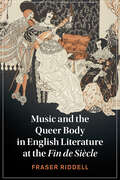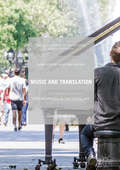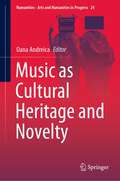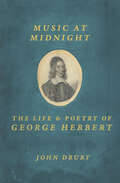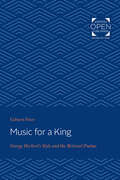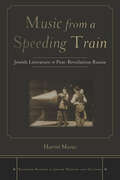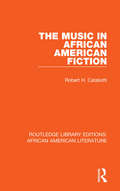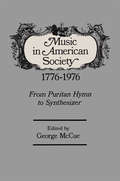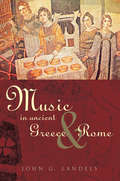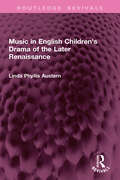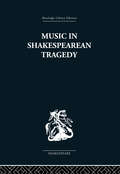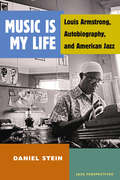- Table View
- List View
Mushroom Clouds: Ecocritical Approaches to Militarization and the Environment in East Asia (Routledge Studies in World Literatures and the Environment)
by Simon C. Estok, Iping Liang, and Shinji IwamasaMushroom Clouds: Ecocritical Approaches to Militarization and the Environment in East Asia examines the growing significance of the eco-implications of the increasing militarism of East Asia. As a transcultural image and metaphor, mushroom clouds signify anthropogenic violence and destruction, as exemplified by wars and nuclear bombings. Immediately evoking memories of Hiroshima and Nagasaki, the mushroom clouds metaphor has deep roots and implications in East Asia, and this volume explores these roots and implications from the perspectives of a variety of scholars and artists from different parts of East Asia. The chapters that comprise Mushroom Clouds respond to the increasingly dangerous developments in the world that led up to and have occurred since the 2016 presidential election of Donald Trump, developments that threaten the stability of the region and the world. In the wake of the 70th anniversary of the division of Korea, increasing attention has been focused on the legacy of the Cold War, on the one hand, and on the continuing militarization of East Asia, on the other. After the nuclear bombings in Hiroshima and Nagasaki, after the truce across the 38th parallel, after the shelling of Kinmen and Matsu, East Asia became (and remains) one of the most densely militarized regions in the world. Under the shadow of war, however, the concern about environmental impacts has been growing, not only in social discourse but also in literature and the visual arts. The first of its kind, Mushroom Clouds gathers ecocritics from East Asia to examine issues such as militarization, militarized islands, military tourism, military villages, post-war environments, nuclear accidents, and the demilitarized sone (DMZ) wildlife, among others, in East Asia.
Music and Gender in English Renaissance Drama (Routledge Advances in Theatre & Performance Studies)
by Katrine K. WongThis book offers a survey of how female and male characters in English Renaissance theatre participated and interacted in musical activities, both inside and outside the contemporary societal decorum. Wong’s analysis broadens our understanding of the general theatrical representation of music, or musical dramaturgy, and complicates the current discussion of musical portrayal and construction of gender during this period. Wong discusses dramaturgical meanings of music and its association with gender, love, and erotomania in Renaissance plays. The negotiation between the dichotomous qualities of the heavenly and the demonic finds extensive application in recent studies of music in early modern English plays. However, while ideological dualities identified in music in traditional Renaissance thinking may seem unequivocal, various musical representations of characters and situations in early modern drama would prove otherwise. Wong, building upon the conventional model of binarism, explores how playwrights created their musical characters and scenarios according to the received cultural use and perception of music, and, at the same time, experimented with the multivalent meanings and significance embodied in theatrical music.
Music and Identity in Postcolonial British South-Asian Literature (Routledge Interdisciplinary Perspectives on Literature)
by Christin HoeneThis book examines the role of music in British-South Asian postcolonial literature, asking how music relates to the construction of postcolonial identity. It focuses on novels that explore the postcolonial condition in India, Pakistan, and the United Kingdom: Vikram Seth's A Suitable Boy, Amit Chaudhuri's Afternoon Raag, Suhayl Saadi's Psychoraag, Hanif Kureishi's The Buddha of Suburbia and The Black Album, and Salman Rushdie's The Ground Beneath Her Feet, with reference to other texts, such as E.M. Forster's A Passage to India and Vikram Seth's An Equal Music. The analyzed novels feature different kinds of music, from Indian classical to non-classical traditions, and from Western classical music to pop music and rock 'n' roll. Music is depicted as a cultural artifact and as a purely aestheticized art form at the same time. As a cultural artifact, music derives meaning from its socio-cultural context of production and serves as a frame of reference to explore postcolonial identities on their own terms. As purely aesthetic art, music escapes its contextual meaning. The transgressive qualities of music render it capable of expressing identities irrespective of origin and politics of location. Thereby, music in the novels marks a very productive space to imagine the postcolonial nation and to rewrite imperial history, to express the cultural hybridity of characters in-between nations, to analyze the state of the nation and life in the multicultural diaspora of contemporary Great Britain, and to explore the ramifications of cultural globalization versus cultural imperialism. It will be a useful research and teaching tool for those interested in postcolonial literature, music studies, cultural studies, contemporary literature and South-Asian literature.
Music and Identity in Twentieth-Century Literature from Our America
by Marco Katz MontielIntellectual discussions have fallen short of developing a truly hemispheric view of the Americas thus far. With eye towards filling this gap, Music and Identity in Twentieth-Century Literature from Our America, written by a professional musician turned literary scholar, offers a one-of-a-kind approach to exploring American homologies while taking account of national and regional differences. Based on an interdisciplinary Cultural Studies approach, this new methodology brings rigorous musicianship and critical literary theory to consider relationships between musical protagonists from Colombia, Cuba, and the United States in novels by Gabriel Garcia Marquez, Alejo Carpentier, Zora Neale Hurston, and John Okada. In addition to providing useful ideas for inter-American studies, this book opens up new ways of reading texts related to Latin American, African American, and Asian American studies. "
Music and Myth in Modern Literature (Among the Victorians and Modernists)
by Josh TorabiThis book is the first major study that explores the intrinsic connection between music and myth, as Nietzsche conceived of it in The Birth of Tragedy (1872), in three great works of modern literature: Romain Rolland’s Nobel Prize winning novel Jean-Christophe (1904-12), James Joyce’s modernist epic Ulysses (1922), and Thomas Mann’s late masterpiece Doctor Faustus (1947). Juxtaposing Nietzsche’s conception of the Apollonian and Dionysian with narrative depictions of music and myth, Josh Torabi challenges the common view that the latter half of The Birth of Tragedy is of secondary importance to the first. Informed by a deep knowledge of Nietzsche’s early aesthetics, the book goes on to offer a fresh and original perspective on Ulysses and Doctor Faustus, two world-famous novels that are rarely discussed together, and makes the case for the significance of Jean-Christophe, which has been unfairly neglected in the Anglophone world, despite Rolland’s status as a major figure in twentieth-century intellectual and literary history. This unique study reveals new depths to the work of our most enduring writers and thinkers.
Music and Poetry in a Colombian Village: A Tri-Cultural Heritage
by George ListThe history and an analysis of the folk music and poetry from the small village in Colombia.
Music and Sound in the Life and Literature of James Joyce: Joyces Noyces (Palgrave Studies in Music and Literature)
by Gerry SmythMusic and Sound in the Life and Literature of James Joyce: Joyces Noyces offers a fresh perspective on the Irish writer James Joyce’s much-noted obsession with music. This book provides an overview of a century-old critical tradition focused on Joyce and music, as well as six in-depth case studies which revisit material from the writer’s career in the light of new and emerging theories. Considering both Irish cultural history and the European art music tradition, the book combines approaches from cultural musicology, critical theory, sound studies and Irish studies. Chapters explore Joyce’s use of repetition, his response to literary Wagnerism, the role and status of music in the aesthetic and political debates of the fin de siècle, music and cultural nationalism, ubiquitous urban sound and ‘shanty aesthetics’. Gerry Smyth revitalizes Joyce’s work in relation to the ‘noisy’ world in which the author wrote (and his audience read) his work.
Music and the Environment in Dystopian Narrative: Sounding The Disaster (Palgrave Studies In Music And Literature Ser.)
by Heidi HartMusic and the Environment in Dystopian Narrative: Sounding the Disaster investigates the active role of music in film and fiction portraying climate crisis. From contemporary science fiction and environmental film to “Anthropocene opera,” the most arresting eco-narratives draw less on background music than on the power of sound to move fictional action and those who receive it. Beginning with a reflection on a Mozart recording on the 1970s’ Voyager Golden Record, this book explores links between music and violence in Lidia Yuknavitch’s 2017 novel The Book of Joan, songless speech in the opera Persephone in the Late Anthropocene, interrupted lyricism in the eco-documentary Expedition to the End of the World, and dread-inducing hurricane music in the Brecht-Weill opera Rise and Fall of the City of Mahagonny. In all of these works, music allows for a state of critical vulnerability in its hearers, communicating planetary crisis in an embodied way.
Music and the Forms of Life
by Lawrence KramerInventors in the age of the Enlightenment created lifelike androids capable of playing music on real instruments. Music and the Forms of Life examines the link between such simulated life and music, which began in the era's scientific literature and extended into a series of famous musical works by Haydn, Mozart, and Beethoven. Music invented auditory metaphors for the scientific elements of life (drive, pulse, sensibility, irritability, even metabolism), investigated the affinities and antagonisms between life and mechanism, and explored questions of whether and how mechanisms can come to life. The resulting changes in the conceptions of both life and music had wide cultural resonance at the time, and those concepts continued to evolve long after. A critical part of that evolution was a nineteenth-century shift in focus from moving androids to the projection of life in motion, culminating in the invention of cinema. Weaving together cultural and musical practices, Lawrence Kramer traces these developments through a collection of case studies ranging from classical symphonies to modernist projections of waltzing specters by Mahler and Ravel to a novel linking Bach's Goldberg Variations to the genetic code.
Music and the Queer Body in English Literature at the Fin de Siècle (Cambridge Studies in Nineteenth-Century Literature and Culture #137)
by Fraser RiddellDrawing on an ambitious range of interdisciplinary material, including literature, musical treatises and theoretical texts, Music and the Queer Body explores the central place music held for emergent queer identities in the late-nineteenth and early-twentieth centuries. Canonical writers such as Walter Pater, E. M. Forster and Virginia Woolf are discussed alongside lesser-known figures such as John Addington Symonds, Vernon Lee and Arthur Symons. Engaging with a number of historical case studies, Fraser Riddell pays particular attention to the significance of embodiment in queer musical subcultures and draws on contemporary queer theory and phenomenology to show how writers associate music with shameful, masochistic and anti-humanist subject positions. Ultimately, this study reveals how literary texts at the fin de siècle invest music with queer agency: to challenge or refuse essentialist identities, to facilitate re-conceptions of embodied subjectivity, and to present alternative sensory experiences of space and time. This title is also available as Open Access on Cambridge Core.
Music and Translation: New Mediations in the Digital Age (Palgrave Studies in Translating and Interpreting)
by Lucile DesblacheThis book explores how transformations and translations shape musical meanings, developments and the perception of music across cultures. Starting with the concept of music as multimodal text, the author understands translation as the process of transferring a text from one language – verbal or not – into another, interlingually, intralingually or intersemiotically, as well as the products that are derived from this process. She situates music and translation within their contemporary global context, examining the tensions between local and global, cosmopolitan and national, and universal and specific settings, to arrive at a celebration of the translational power of music and an in-depth study of how musical texts are translated. This book will be of interest to translation studies scholars who want to broaden their horizons, as well as to musicians and music scholars seeking to understand how cultural exchange and dissemination can be driven by translation.
Music as Cultural Heritage and Novelty (Numanities - Arts and Humanities in Progress #24)
by Oana AndreicaThis book provides a multifaceted view on the relation between the old and the new in music, between tradition and innovation. This is a much-debated issue, generating various ideas and theories, which rarely come to unanimous conclusions. Therefore, the book offers diverse perspectives on topics such as national identities, narrative strategies, the question of musical performance and musical meaning. Alongside themes of general interest, such as classical repertoire, the music of well-established composers and musical topics, the chapters of the book also touch on specific, but equally interesting subjects, like Brazilian traditions, Serbian and Romanian composers and the lullaby. While the book is mostly addressed to researchers, it can also be recommended to students in musicology, ethnomusicology, musical performance, and musical semiotics.
Music at Midnight: The Life and Poetry of George Herbert
by John DruryThough he never published any of his English poems during his lifetime, George Herbert (1593-1633) is recognized as possibly the greatest religious poet in the language. Few English poets of his age still inspire such intense devotion today. In this richly perceptive biography, John Drury for the first time integrates Herbert’s poems fully into his life, enriching our understanding of both the poet’s mind and his work. As Drury writes in his preface, Herbert lived "a quiet life with a crisis in the middle of it. ” Drury follows Herbert from his academic success as a young man, seemingly destined for a career at court, through his abandonment of those hopes, his devotion to the restoration of a church in Huntingdonshire, and his final years as a country parson. Because Herbert’s work was only published posthumously, it has always been difficult to know when or in what context Herbert wrote his poems. But Drury skillfully places readings of the poems into his narrative at biographically credible moments, allowing us to appreciate not only Herbert’s frame of mind while writing, but also the society that produced it. A sensitive critic of Herbert’s poems as well as a theologian, Drury does full justice to the spiritual dimension of Herbert’s work. In addition, he reveals the occasions of sorrow, happiness, regret, and hope that Herbert captured in his poetry and that led T. S. Eliot to write, "What we can confidently believe is that every poem . . . is true to the poet’s experience. ” Painting a picture of a man torn between worldly ambition and spiritual life, Music at Midnight is an eloquent biography that breathes new life into some of the greatest English poems ever written.
Music at Midnight: The Life and Poetry of George Herbert
by John DruryThis &“powerfully absorbing&” biography of 17th century Welsh poet George Herbert brings essential personal and social context to his immortal poetry (Financial Times). Though he never published any of his English poems during his lifetime, George Herbert has been celebrated for centuries as one of the greatest religious poets in the language. In this richly perceptive biography, author and theologian John Drury integrates Herbert&’s poems fully into his life, enriching our understanding of both the poet&’s mind and his work. As Drury writes in his preface, Herbert lived &“a quiet life with a crisis in the middle of it.&” Beginning with his early academic success, Drury chronicles the life of a man who abandons the path to a career at court and chooses to devote himself to the restoration of a church in Huntingdonshire and lives out his life as a country parson. Because Herbert&’s work was only published posthumously, it has always been difficult to know when or in what context he wrote his poems. But Drury skillfully places readings of the poems into his narrative, allowing us to appreciate not only Herbert&’s frame of mind while writing, but also the society that produced it. He reveals the occasions of sorrow, happiness, regret, and hope that Herbert captured in his poetry and that led T. S. Eliot to write, &“What we can confidently believe is that every poem . . . is true to the poet&’s experience.&” &“It is hard to imagine a better book for anyone, general reader or seventeenth-century aficionado or teacher or student, newly embarking on Herbert.&”—The Guardian, UK
The Music between Us: Is Music a Universal Language?
by Higgins Kathleen MarieFrom our first social bonding as infants to the funeral rites that mark our passing, music plays an important role in our lives, bringing us closer to one another. In The Music between Us, philosopher Kathleen Marie Higgins investigates this role, examining the features of human perception that enable music's uncanny ability to provoke, despite its myriad forms across continents and throughout centuries, the sense of a shared human experience. Drawing on disciplines such as philosophy, psychology, musicology, linguistics, and anthropology, Higgins's richly researched study showcases the ways music is used in rituals, education, work, healing, and as a source of security and--perhaps most importantly--joy. By participating so integrally in such meaningful facets of society, Higgins argues, music situates itself as one of the most fundamental bridges between people, a truly cross-cultural form of communication that can create solidarity across political divides. Moving beyond the well-worn takes on music's universality, The Music between Us provides a new understanding of what it means to be musical and, in turn, human.
Music for a King: George Herbert's Style and the Metrical Psalms
by Coburn FreerOriginally published in 1972. Music for a King tries to study the affinities in form and matter between the versified translation of the Psalms and George Herbert's lyrics. Coburn Freer reads Herbert's poetry by way of the metrical psalms that precede it, proposing a reading that could be applied to more poems than are discussed here. Rather than multiply examples needlessly, this book stresses a few central poems as models or representatives. This reading of Herbert recognizes the historical dimension of his poems, but the author does not make that dimension the only significant one in the determination of poetic meaning or value.
Music from a Speeding Train
by Harriet MuravMusic from a Speeding Trainexplores the uniquely Jewish space created by Jewish authors working within the limitations of the Soviet cultural system. It situates Russian- and Yiddish- language authors in the same literary universe-one in which modernism, revolution, socialist realism, violence, and catastrophe join traditional Jewish texts to provide the framework for literary creativity. These writers represented, attacked, reformed, and mourned Jewish life in the pre-revolutionary shtetl as they created new forms of Jewish culture. The book emphasizes the Soviet Jewish response to World War II and the Nazi destruction of the Jews, disputing the claim that Jews in Soviet Russia did not and could not react to the killings of Jews. It reveals a largely unknown body of Jewish literature beginning as early as 1942 that responds to the mass killings. By exploring works through the early twenty-first century, the book reveals a complex, emotionally rich, and intensely vibrant Soviet Jewish culture that persisted beyond Stalinist oppression.
The Music in African American Fiction: Representing Music In African American Fiction (Routledge Library Editions: African American Literature #2)
by Robert H. CataliottiOriginally published in 1995, The Music of African American Fiction is a historical analysis of the tradition of representing music in African American fiction. The book examines the impact of evolving musical styles and innovative musicians on black culture as is manifested in the literature. The analysis begins with the slave narratives and the emergence of the first black fiction of the antebellum years and moves through the Reconstruction. This is followed by analyses of definitive fictional representations of African American music from the turn-of-the-century through Harlem Renaissance, the Depression and World War II eras through the 1960s and the Black Arts Movement. The representation of black music shapes a lineage that extends from the initial chronicles written in response to sub-human bondage to the declarations of an autonomous "black aesthetic" and dramatically influences the evolution of an African American literary tradition.
Music in American Society: From Puritan Hymn To Synthesizer
by George McCueThis book is the literary legacy of a national music festival in St. Louis, organized to identify as clearly as possible the specifically native character of music originating in the United States of America. The festival—the Bicentennial Horizons of American Music and the Performing Arts (B.H.A.M.)—sponsored more than 250 performances and workshops between Flag Day and Independence Day 1976. It was the only event of the Bicentennial celebration to address itself to a survey and evaluation of the musical development of this country.
Music in Ancient Greece and Rome
by John G LandelsMusic in Ancient Greece and Rome provides a comprehensive introduction to the history of music from Homeric times to the Roman emperor Hadrian, presented in a concise and user-friendly way. Chapters include: * contexts in which music played a role * a detailed discussion of instruments * an analysis of scales, intervals and tuning * the principal types of rhythm used * and an exploration of Greek theories of harmony and acoustics.Music in Ancient Greece and Rome also contains numerous musical examples, with illustrations of ancient instruments and the methods of playing them.
Music in Context: Manuscripts and Medieval Song
by Deeming, Helen and Leach, Elizabeth Eva Helen Deeming Elizabeth Eva LeachThe manuscript sources of medieval song rarely fit the description of 'songbook' easily. Instead, they are very often mixed compilations that place songs alongside other diverse contents, and the songs themselves may be inscribed as texts alone or as verbal and musical notation. This book looks afresh at these manuscripts through ten case studies, representing key sources in Latin, French, German, and English from across Europe during the Middle Ages. Each chapter is authored by a leading expert and treats a case study in detail, including a listing of the manuscript's overall contents, a summary of its treatment in scholarship, and up-to-date bibliographical references. Drawing on recent scholarly methodologies, the contributors uncover what these books and the songs within them meant to their medieval audience and reveal a wealth of new information about the original contexts of songs both in performance and as committed to parchment.
Music in English Children's Drama of the Later Renaissance (Routledge Revivals)
by Linda Phyllis AusternOriginally published in 1992, Music in English Children’s Drama of the Later Renaissance is the first book-length study to examine the Elizabethan and Jacobean children’s drama, not only from a musicological perspective, but also drawing on the histories of literature, culture, and the theater. It gives the children’s companies new historical significance, showing that they were an integral and ultimately influential part of the London theatrical world. These companies originated important features of later drama, such as music before and between acts, and the exploitation of different timbres for specific effects.Those interested in music history, English literature, theater history, and cultural history will find this a comprehensive and fascinating study. Of special note are the appendices, which offer a unique and important reference source by providing the only definitive list of the plays and songs used by the children.
Music in Shakespearean Tragedy
by F W SternfeldFirst published in 1963. When originally published this book was the first to treat at full length the contribution which music makes to Shakespeare's great tragedies, among them Hamlet, Othello, and King Lear. Here the playwright's practices are studied in conjunction with those of his contemporaries: Marlowe and Jonson, Marston and Chapman. From these comparative assessments there emerges the method that is peculiar to Shakespeare: the employment of song and instrumental music to a degree hitherto unknown, and their use as an integral part of the dramatic structure.
Music in the Georgian Novel
by Pierre DuboisMusic was an essential aspect of life in eighteenth-century Britain and plays a crucial role in the literary strategies of Georgian novels. This book is the first to investigate the literary representation of music in these works and explores the structural, dramatic and metaphorical roles of music in novels by authors ranging from Richardson to Austen. Pierre Dubois explores the meaning of 'musical scenes' by framing them within contemporary cultural issues, such as the critique of Italian opera or the theoretical shift from mimesis to the alleged autonomy and mystery of music. Focusing upon both eighteenth-century theories of music, and the way specific musical instruments were perceived in the collective imagination, Dubois suggests new interpretative perspectives for a whole range of novels of the Georgian era. This book will be of interest to a wide readership interested not only in literature, but also in music and cultural history at large.
Music Is My Life: Louis Armstrong, Autobiography, and American Jazz
by Daniel SteinMusic Is My Lifeis the first comprehensive analysis of Louis Armstrong's autobiographical writings (including his books, essays, and letters) and their relation to his musical and visual performances. Combining approaches from autobiography theory, literary criticism, intermedia studies, cultural history, and musicology, Daniel Stein reconstructs Armstrong's performances of his life story across various media and for different audiences, complicating the monolithic and hagiographic views of the musician. The book will appeal to academic readers with an interest in African American studies, jazz studies, musicology, and popular culture, as well as general readers interested in Armstrong's life and music, jazz, and twentieth-century entertainment. While not a biography, it provides a key to understanding Armstrong's oeuvre as well as his complicated place in American history and twentieth-century media culture.
